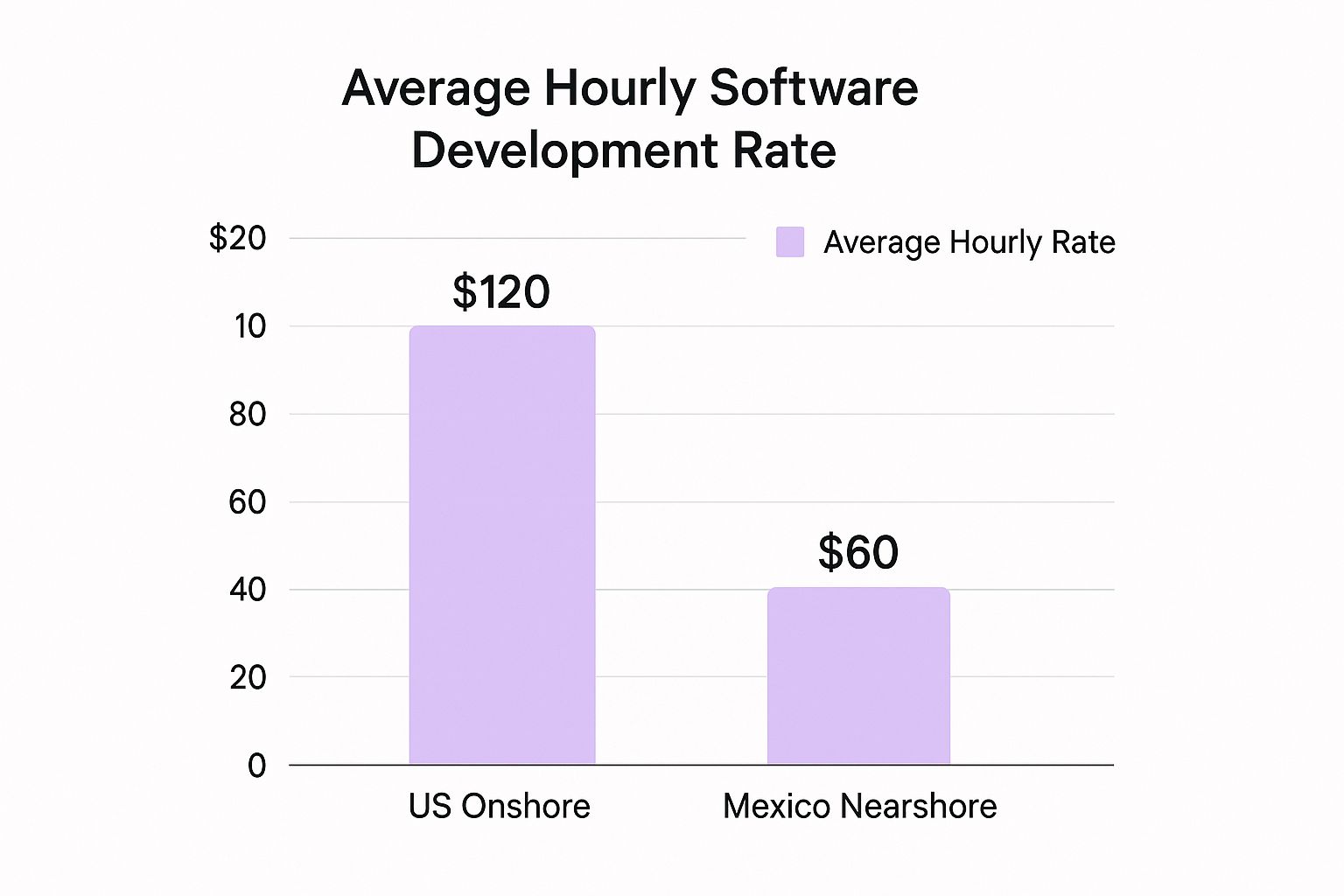
When you hear "nearshore software development in Mexico," what should come to mind is a powerful strategy for tapping into elite, affordable engineers who can work in lockstep with your US-based teams. The idea is brilliantly simple: you get a highly skilled development team without the frustrating communication delays and time-zone headaches that plague traditional offshoring. For businesses looking to scale their tech capabilities, this approach is a serious competitive advantage.
More and more, companies are looking beyond their own borders for top-tier tech talent, and Mexico has quickly risen to the top of the list. This isn't just about saving a few bucks; it's a strategic move to build and scale development teams more intelligently. Businesses are increasingly turning to nearshoring as one of their core strategies for reducing costs and accessing global talent.
This model hits the sweet spot between expensive domestic hiring and the logistical maze of traditional offshoring. By partnering with developers just a stone's throw away, you truly get the best of both worlds.
Mexico’s transformation into a tech powerhouse didn't happen overnight. It’s the fruit of deliberate investment in technical education, a stable economy, and a national commitment to innovation. The country is now consistently graduating a deep pool of qualified engineers ready to tackle complex, demanding projects.
And this isn't just talk—the numbers back it up. Let's look at the data that paints a clear picture of Mexico's tech boom.
Mexico Nearshoring Quick Facts
| Metric | Statistic | Business Impact |
|---|---|---|
| Tech Market Size | Projected $4.86 billion in revenue by 2025 | A mature and stable market reduces investment risk and ensures a robust ecosystem of partners and services. |
| Talent Pool Size | Over 700,000 tech professionals | A massive talent pool means easier access to specialized skills and less competition for qualified candidates. |
| Cost Savings | Average 50% or more compared to US rates | Significant budget relief allows for larger teams, extended project runways, and accelerated product development. |
| Time Zone Overlap | 90% alignment with US business hours | Real-time collaboration, instant communication, and agile workflows become the default, not the exception. |
| Cultural Proximity | High affinity with US business culture | Smoother team integration, fewer misunderstandings, and a shared work ethic lead to higher productivity. |
As the table shows, Mexico is far more than just a source of temporary help. It offers the foundation for long-term, strategic partnerships that can integrate seamlessly into your company’s workflow and culture, fueling real innovation and growth.
Let's be direct: one of the biggest draws to nearshoring in Mexico is the dramatic cost efficiency. But it’s more than just lower salary figures. It’s about cutting down on overhead, reducing administrative burdens, and freeing up capital to reinvest where it matters most—in your product.
This chart really puts the difference in perspective, showing the average hourly rates for developers in the US versus Mexico.

The data is pretty compelling. You’re often looking at savings of 50% or more, all while maintaining an incredibly high bar for engineering talent. This kind of financial leverage allows both scrappy startups and established enterprises to stretch their development budgets further and hit their roadmap goals faster.

The high-level benefits of nearshoring are easy to grasp, but the real magic happens when you look at the day-to-day operational wins. Forget the generic talking points. A partnership with a Mexican tech team delivers tangible, lasting advantages that go way beyond a simple line item on your budget.
Think of your development process less like a disjointed relay race across continents and more like a fluid, collaborative workshop. That’s the reality that strategic nearshore software development in Mexico unlocks. The goal isn't just managing time differences; it's about maximizing shared work hours for genuine, deep integration.
The most immediate and powerful advantage is the shared workday. It’s a complete game-changer. Since most of Mexico operates on Central Time (CT), your US and Mexican teams can collaborate in real time. This isn't just a small convenience—it fundamentally boosts your project's velocity and quality.
Consider the practical difference this makes:
This time zone sync transforms your nearshore partners from a siloed "outsourced team" into a true extension of your domestic crew. You get a more cohesive, responsive, and effective development machine.
The conversation around cost often gets oversimplified. Yes, Mexican developers command competitive salaries—often 50-70% lower than their US counterparts—but the financial upside runs much deeper. It’s really about getting smarter with your entire technology budget.
The lower cost of living in Mexico means operational overheads like office space, utilities, and administrative support are also significantly less. Those savings are passed on to you, letting you build a bigger, more capable team for the same investment.
This financial leverage means you can afford to hire two or three highly skilled engineers in Mexico for the cost of one in a major US tech hub. This isn't just about filling seats; it’s about accelerating your product roadmap and out-innovating your competitors.
This efficiency is further amplified by the strong retention rates in Mexico's tech sector. You spend less time and money on the disruptive cycle of recruiting, hiring, and onboarding, creating a model built for sustainable, long-term growth.
Perhaps the most underrated benefit is the strong cultural alignment between Mexico and the United States. Decades of close economic and social ties have created a shared cultural context that smooths out the friction points that so often derail offshore projects.
Professionals in Mexico are typically very familiar with US business etiquette, communication norms, and work ethics. This flattens the learning curve and sidesteps the misinterpretations that can plague teams from vastly different cultural backgrounds.
This shared understanding shows up in a few key ways:
This cultural bridge is strengthened by Mexico's massive investment in IT education and its booming tech market. With a projected annual growth of 11.3% over the next four years, Mexico is cementing its spot among the world's top destinations for nearshore programming.
This potent mix creates a powerful synergy. You get a team that not only has the right technical chops but also integrates seamlessly into your company culture. Exploring the rich LatAm talent for software development projects can offer even deeper insights into how this regional expertise can transform your organization.
The real power of nearshore software development in Mexico isn't just about saving money or aligning schedules. It's about the people. The success of your project will ultimately come down to the quality of the engineers you bring on board, and Mexico's tech ecosystem is brimming with highly skilled, motivated professionals. This isn't about finding a few coders; it's about accessing a deep, well-educated, and ambitious workforce.
But Mexico's tech scene isn't one giant, uniform entity. It’s a network of thriving city-hubs, each with its own flavor and specializations. Knowing where to look is the first step to finding the perfect extension of your in-house team. These cities are the engines powering Mexico's rise as a premier technology partner.
While you can find great talent across the country, three cities have become the undeniable powerhouses. They're magnets for the best minds, the biggest investments, and the most challenging projects.
Guadalajara: The Silicon Valley of Mexico
It’s a nickname that’s been well and truly earned. Guadalajara is the mature, established heart of Mexico's tech industry, with a long track record of successful collaborations with international companies. Major global players have set up shop here, creating a competitive, high-achieving environment that keeps the talent sharp.
Mexico City: The Bustling Metropolis
As the nation's capital and largest city, Mexico City offers a talent pool of staggering size and diversity. The sheer scale means you can find developers with practically any skill set you can imagine. It’s also a hub for finance, media, and other major industries, which has created pockets of specialized tech talent that deeply understand specific business domains.
Monterrey: The Industrial and Tech Hybrid
Known for its powerful work ethic and industrial might, Monterrey brings a culture of engineering excellence to the table. Its world-class universities, like the Tecnológico de Monterrey, produce a steady stream of disciplined and technically brilliant graduates, making it a hotspot for complex, mission-critical software projects.
The talent pool in Mexico is both broad and deep. You’ll have no trouble finding experts in the foundational languages and frameworks that run modern software, like JavaScript (React, Node.js), Python, and Java.
But the expertise goes far beyond the basics. As global tech demands evolve, so do the skills of Mexico’s developers.
You can now build a complete, highly specialized nearshore team in Mexico with deep expertise in advanced fields like Artificial Intelligence (AI) and Machine Learning (ML), cloud computing (AWS, Azure, GCP), and robust cybersecurity practices.
This isn't a happy accident. It's the direct result of a national focus on higher education. Mexico graduates over 130,000 engineers and technicians every single year. These universities and technical schools often work hand-in-glove with industry leaders, ensuring their programs are teaching the skills companies actually need. The result? Graduates who are ready to hit the ground running.
Maybe the most compelling proof of Mexico’s talent quality is where the tech giants are putting their money. Companies like Google, IBM, Oracle, and HP haven’t just tested the waters; they’ve built massive, long-term development centers in the country.
These corporations are famously picky. They have incredibly tough vetting processes and demand nothing less than world-class work. Their continued investment and expansion in hubs like Guadalajara and Monterrey is a loud and clear endorsement. They wouldn't be there if the local engineers couldn't deliver. For smaller companies, this big-tech validation de-risks the entire proposition.
Of course, finding great talent is just the beginning. Building a cohesive, high-performing distributed team is a discipline in itself. To make the partnership truly work, it's smart to explore strategies to effectively engage remote teams and set the foundation for strong collaboration from day one.

Let's be blunt: choosing your nearshore partner is the most critical decision you'll make in this entire process. Get it right, and they become a seamless extension of your company, pushing your roadmap forward. Get it wrong, and you’re looking at missed deadlines, blown budgets, and a whole lot of frustration.
A successful partnership for nearshore software development in Mexico isn’t about finding the cheapest hourly rate. It's about finding a team that genuinely clicks with your technical needs, your company culture, and your long-term vision. To get there, you need a solid playbook.
Before you even think about looking at potential partners, you need to decide how you want to work with them. The structure of your relationship will define the kind of partner you should be looking for. There are three main ways this plays out, each built for different goals.
Staff Augmentation: Think of this as hiring a specialist to plug a specific gap in your existing team. You bring on one or more developers who report directly to your internal managers. It’s perfect for short-term projects or when you desperately need an expert in a technology you don’t have in-house.
Dedicated Team: This is a much deeper commitment. Your nearshore partner builds a complete, self-managing team that works only on your projects. This unit includes developers, QA testers, and a project manager, all functioning as your own remote squad. This is the go-to model for long-term, complex product development where you need the team to build deep domain knowledge.
Project-Based: With this model, you hand over a project with a clearly defined scope, a fixed timeline, and specific deliverables. The partner takes it from there, managing the entire development lifecycle. This works wonders for well-defined, one-off projects where the outcome can be clearly specified from the start.
Choosing the right model sets the entire foundation for your search. A firm that excels at project-based work probably isn't your best bet if what you really need is a deeply integrated, dedicated team.
Once you know the how, it's time to vet the who. You have to get your hands dirty and rigorously assess a potential partner's technical chops. Don't just take their marketing materials at face value—demand proof.
Start with their portfolio and case studies. Look for projects that mirror yours in industry, complexity, and tech stack. A partner with a proven track record of building successful FinTech apps is going to be a much safer bet for your mobile banking project than a team that mostly builds e-commerce sites.
A strong portfolio isn't just a gallery of pretty screenshots. It should tell a story: what was the business problem, what was the technical solution, and what were the measurable results? If a case study is vague on the outcomes, that's a red flag.
Next, get your own senior engineers to conduct technical interviews with their proposed team members. These conversations should be designed to truly test problem-solving skills and depth of knowledge. Don't shy away from giving candidates a small, paid coding challenge to see how they actually work.
A team of brilliant coders is useless if they can't manage a project or communicate clearly. This is precisely where most outsourcing relationships break down. You need a partner whose internal processes are in lockstep with yours.
Ask them direct, pointed questions about how they operate:
Their answers should reveal a mature, disciplined approach. The goal is to establish a seamless flow of information that nips misunderstandings in the bud and keeps everyone on the same page. For a deeper dive into building out your remote team, our guide on how to hire nearshore developers offers practical advice and best practices.
Finally, always check references. Talk to a potential partner's current and former clients. Ask them the tough questions about communication, transparency, code quality, and—most importantly—how the team handled things when the unexpected happened. This real-world feedback is often the most telling part of the whole process.
Taking your business into a new country always brings up questions about legal protections and staying compliant. Let's be honest, it's a major concern. When you're looking at nearshore software development in Mexico, you can breathe a little easier. The country has a modern, robust legal framework built to protect your interests and encourage secure, business-friendly partnerships.
This isn't the Wild West. Mexico has deliberately aligned its laws with international standards, creating a predictable and safe environment for foreign companies, especially in tech.
For any tech company, the source code, algorithms, and proprietary data are the crown jewels. So, the big question is: are they safe in Mexico? The short answer is yes. Mexico’s intellectual property (IP) laws are strong and designed to give you comprehensive protection.
Mexico is a signatory to major international IP treaties, like the Berne Convention (which covers software) and the TRIPS Agreement. These treaties mean your IP rights are recognized and can be enforced just as they would be in the United States or Europe.
Under Mexican law, the software you commission is typically treated as a "work made for hire." As long as your contract is buttoned up correctly, this means the full ownership of the source code and all related IP automatically belongs to your company, not the developers who built it.
To add another layer of security, it's standard practice to have your nearshore partner—and their individual employees—sign solid confidentiality and IP assignment agreements. This creates a multi-layered legal shield around your tech.
In a world where data privacy isn't just a feature but a requirement, Mexico has kept up. The Federal Law on Protection of Personal Data Held by Private Parties (LFPDPPP) is the country's main data protection law.
If it sounds a bit like GDPR, that's intentional. The law borrows from international frameworks to set clear rules for how personal data is collected, used, stored, and secured. If you handle user data, working with a Mexican partner who knows the ins and outs of LFPDPPP is non-negotiable for staying compliant.
A reputable nearshore firm in Mexico will already have strict internal data security protocols in place. This ensures your operations meet Mexican law and the standards of regulations like GDPR or CCPA. For a deeper dive, exploring the legal aspects of hiring remote workers in LatAm can give you a broader perspective on your entire engagement strategy.
The bedrock of any great nearshore partnership is a well-written contract. Your Master Service Agreement (MSA) and Statement of Work (SOW) are the rulebooks for the entire relationship.
These documents need to clearly spell out the essentials:
Before you even start discussing project details, you should get familiar with standard legal tools like Non-Disclosure Agreements. These are a must-have in any tech partnership, providing a crucial layer of protection from day one. Working with a nearshore partner who understands and respects these legal instruments isn't just a good idea—it's essential.
When you’re considering a new business strategy like nearshoring, questions are a good thing. They’re a sign you’re doing your due diligence. For leaders looking at nearshore software development in Mexico, a few practical concerns almost always come up.
Getting straight answers is the only way to move forward with confidence. So, let's tackle the most common questions head-on, breaking them down into simple, actionable insights. This will help you see the real potential of a partnership in Mexico and how to make it work for you.
This is always the first question, and for good reason. While salaries are a huge piece of the puzzle, they don’t tell the whole story. The real savings from nearshoring in Mexico go way beyond a lower number on a developer's paycheck.
It's like buying a car. The sticker price is just the starting point. You still have to factor in insurance, gas, maintenance, and registration. The total cost of an employee is the same—it’s much more than just their salary.
A mid-level software developer in the U.S. might have a salary north of $120,000, but the fully-loaded cost to the company can easily top $160,000 a year. That extra amount comes from:
In Mexico, a developer with the same skill set might have a salary that's 50-60% lower. But the real magic happens because your nearshore partner takes care of all that overhead. The price you pay covers everything: recruiting, HR, benefits, office space, and legal compliance. This makes your costs predictable and significantly lower overall.
For the cost of one fully-loaded senior developer in a major US tech hub, you can often build a team of two or three highly skilled engineers in Mexico. This isn't just about cutting costs; it's a strategic move to multiply your development power and get your product to market faster.
Another big one. How do you keep a team hundreds of miles away perfectly in sync with your people at home? The secret is being intentional about communication from day one.
The shared time zones with Mexico give you a massive advantage right out of the gate, solving the biggest problem of traditional offshoring. But you still need a solid framework to make the most of it.
A successful setup almost always includes these elements:
By establishing these rituals and tools, you build a communication rhythm that makes distance feel irrelevant. Your nearshore team becomes a genuine extension of your own, not some siloed third party.
This is a deal-breaker, and the answer is a firm yes—as long as you partner with a reputable firm. Mexico has a strong legal framework for intellectual property (IP) that’s closely aligned with international standards and designed to protect foreign investment.
Mexico is a signatory to major international agreements like the Berne Convention, which treats software as a literary work. Your code gets the same fundamental protections it would in the United States. On top of that, modern trade agreements like the USMCA have reinforced these IP protections, creating a secure environment for tech collaboration.
Here’s how a standard nearshoring engagement protects your IP contractually:
Your IP is the lifeblood of your company. Any professional partner in Mexico gets this, and they’ll have these legal safeguards built into their process as a non-negotiable standard.
Guadalajara has definitely earned its title as the "Silicon Valley of Mexico," but it's not the only game in town. The tech scene in Mexico is surprisingly diverse, with several other cities offering incredible talent pools and their own unique strengths.
Looking beyond the obvious can help you find the perfect match for your company's specific needs. Here are a few other major hubs to put on your radar:
